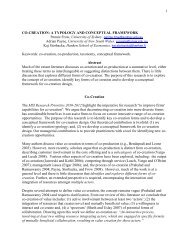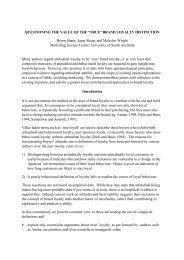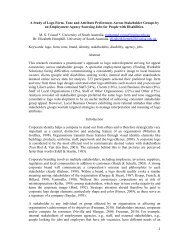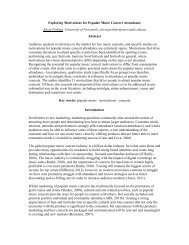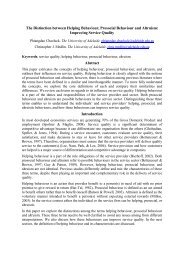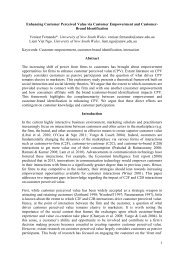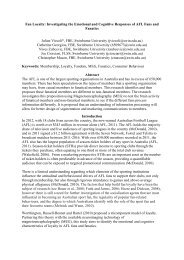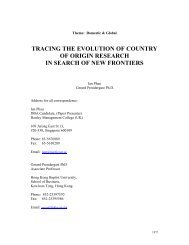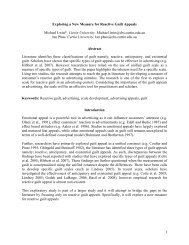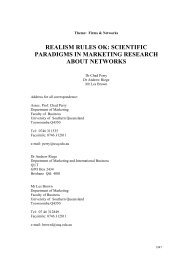UNDERSTANDING CONSUMER INTENTIONS TO ... - ANZMAC
UNDERSTANDING CONSUMER INTENTIONS TO ... - ANZMAC
UNDERSTANDING CONSUMER INTENTIONS TO ... - ANZMAC
Create successful ePaper yourself
Turn your PDF publications into a flip-book with our unique Google optimized e-Paper software.
commuting options, one’s perceived ability to undertake carpooling, or the perceived ease of<br />
carpooling, are positively related to carpooling intentions. This is supported by the positive<br />
relationship between Perceived Behavioural Control and Facilitating Resources, and suggests the<br />
importance of resources to one’s sense of control over a situation.<br />
Fourth, previous experience was also found to be directly related to Perceived Behavioural<br />
Control. While this relationship had not been predicted, it makes sense that having had previous<br />
experience would increase one’s sense of control in carpooling situations. Experience was also<br />
found to be directly related to Behavioural Intention, as predicted. The importance of<br />
Experience in influencing Attitude, Perceived Behavioural Control and Behavioural Intention are<br />
all important findings, and have implications for promotion and policy actions.<br />
Although the intent of this study was to compare two models of consumer intentions to<br />
participate in carpooling, the findings also provide insight for increasing carpooling behaviour.<br />
In the carpooling setting, the intention to carpool is determined by one's attitudes toward<br />
carpooling, perceived control over carpooling behaviour, and previous experience. Thus,<br />
policymakers should concentrate on tools to influence attitudes and perceived behavioural<br />
control. Further policy insights can be found in Mollenkopf and Ozanne (1999).<br />
References<br />
Ajzen, Icek and Martin Fishbein (1980), Understanding Attitudes and Predicting Social<br />
Behavior, Prentice-Hall, Englewood Cliffs, NJ.<br />
Ajzen, Icek (1985), “From Intentions to Actions: A Theory of Planned Behavior,” in Action<br />
Control: From Cognition to Behaviour, editors Julius Kuhl and Jurgen Beckmann, Springer-<br />
Verlag, Berlin, 11-39.<br />
---- (1991), “The Theory of Planned Behavior,” Organizational Behavior and Human Decision<br />
Processes, 50, 179-211.<br />
Bagozzi, Richard and P. Dabholkar (1994), “Consumer Recycling Goals and their Effect on<br />
Decisions to Recycle: A Means-end Chain Analysis,” Psychology and Marketing, 11:313-340.<br />
Bonsall, P. W., Spencer, A. H., & Tang, W-S. (1984), "What Makes a Car-sharer?"<br />
Transportation, 12, 117-145.<br />
Cervero, R., & Griesenbeck, B. (1988), "Factors Influencing Commuting Choices in Suburban<br />
Labor Markets: A case Analysis of Pleasanton, California," Transportation Research, 22, 151-<br />
161.<br />
Ferguson, E. (1990), "The Influence of Employer Ridesharing Programs on Employee Mode<br />
Choice," Transportation, 17, 179-207.




